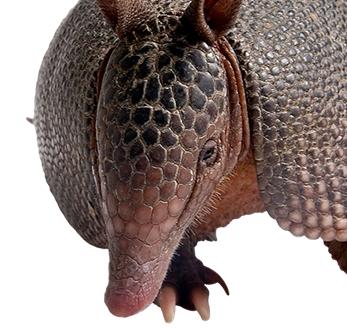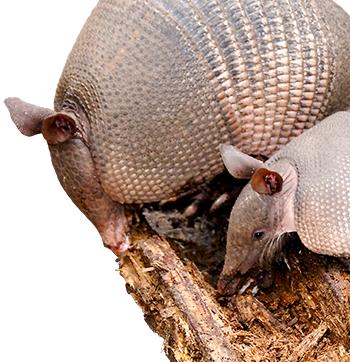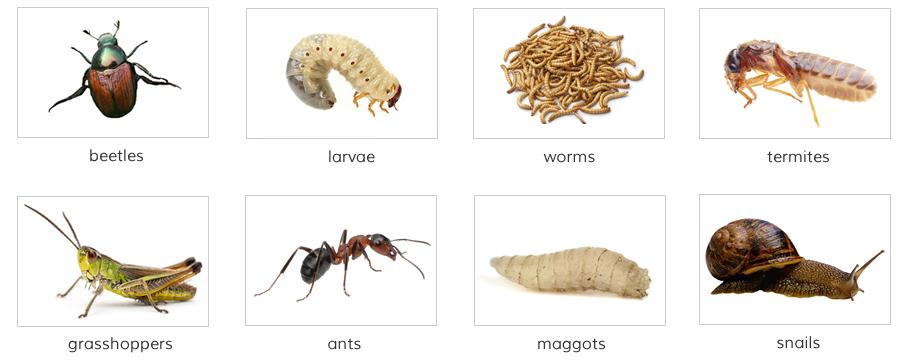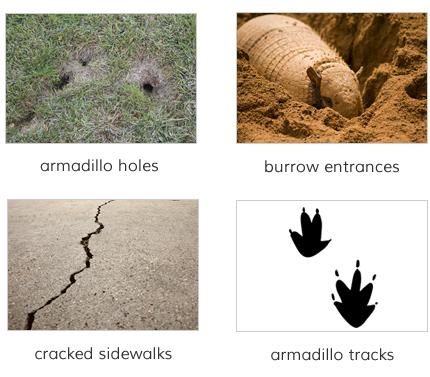





Armadillos
Armadillo Facts
Armadillos are western mammals known for their unique armor-like shell and notorious for their digging habits. One species in particular - the nine-banded armadillo - has made its way into the southern United States, and is the focus of this page. Below, you will learn general facts about the nine-banded armadillo, including information on reproduction and how to identify armadillo damage.

General Armadillo Facts
- Only U.S. Species: Nine-banded armadillo (Dasypus novemcinctus)
- Average Size: 25-48" long (including the tail); 8-18 lb
- Average Lifespan in the Wild: 7-10 years
- Identifying Features: greyish-brown oval-shaped body with a long, tapering tail; long head with a pointy snout and small black eyes on either side; hard, armor-like shell (carapace) with 7-11 distinct band-shaped breaks around the center; four short legs with long claws designed for digging.

Armadillo Geography
All 20 species of armadillos are found in the western hemisphere. Armadillos originated in South America, and a few species have expanded northward due to their rapid breeding cycle, adaptability and a reduction of predators.
The only species that has made it into the United States is the nine-banded species, which inhabits Texas and the Gulf Coast states and can be found as far north as Missouri.

Armadillo Habitat
Armadillos prefer warm, moist climates, and thrive in forested areas and grasslands. Because they must dig for their food and shelter, they generally gravitate towards areas with loose, porous soil.
These animals use their strong claws to dig several burrows throughout their home range in which to live and seek refuge from extreme weather or predators. An armadillo burrow is about 7-8" wide and up to 15 feet deep.
Armadillo Diet
Armadillos are mainly insectivores, with over 90% of their diet consisting of animal matter, like insects and other invertebrates. They're also known to eat the occasional reptile or amphibian - especially in colder weather. The remainder of their diet consists of plant matter, although it's been found that most of the vegetation they eat has been consumed incidentally.
Favorite foods include:

Armadillo Behavior
- Activity: In native southern regions, armadillos are nocturnal year-round, keeping cool underground during the day and foraging at night. However because of the armadillos' relatively low body temperature, the nine-banded species in North America tends to change its habits in the cooler months and emerge during the day to take advantage of the warm sun.
- Reproduction: Reproduction for the nine-banded armadillo begins in early summer, and the breeding period lasts about 2-3 months. It takes up to 4 months for a fertilized egg to become implanted and another 4 before young are born. Each time, the fertilized egg breaks into four identical zygotes, yielding quadruplets.
- Social Interaction: Solitary animals, armadillos spend their lives foraging alone and only interact to breed or care for their young. Young armadillos become independent about 6-12 months after they are born.
- Digging: Armadillos are prolific diggers that excavate land for food and dig profound burrows for shelter. They prefer to dig in areas with loose, porous soil, rich in insects and invertebrates.
Identify Armadillo Damage

Most armadillo damage comes about as a result of their digging habits, taking the forms of holes and burrows.
Signs of armadillo damage include:
- holes throughout lawn, about 3-5" wide and 1-3" deep
- uprooted plants and seedlings
- burrow entrances, about 7-10" in diameter, next to or underneath structures, sidewalks, brush piles, low-lying shrubs, etc.
- damaged underground wires or pipes
- cracked foundation or concrete sidewalk/driveway
- armadillo tracks: four toes in front with elongated center two toes; five toes in back with elongated center three toes; all claws visible.
Armadillo Diseases
Armadillos have the ability to carry the bacterium that causes leprosy in humans (Mycobacterium leprae). However, the risk of contracting leprosy from an armadillo is extremely low. Scientists believe that in order to contract leprosy from an armadillo, one must handle armadillos frequently and/or consume armadillo meat.
Fun Facts
- The smallest species of armadillo is the pink fairy armadillo - only 5-6" long and less than 1 lb in weight.
- One type of armadillo - the three banded armadillo - instinctually rolls itself into a ball when threatened, completely enclosing its body in its armor-like shell to defend against predators.
- "Armadillo" is Spanish for "little armored one".
- When frightened, nine-banded armadillos will jump vertically about 3-4 feet in the air. Scientists believe this is a defense mechanism for scaring potential predators.
- Armadillos can live up to 20+ years in captivity.
